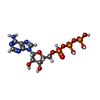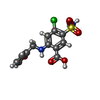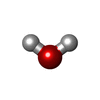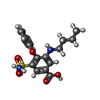+Search query
-Structure paper
| Title | Structural basis for human NKCC1 inhibition by loop diuretic drugs. |
|---|---|
| Journal, issue, pages | EMBO J, Vol. 44, Issue 5, Page 1540-1562, Year 2025 |
| Publish date | Jan 28, 2025 |
 Authors Authors | Yongxiang Zhao / Pietro Vidossich / Biff Forbush / Junfeng Ma / Jesse Rinehart / Marco De Vivo / Erhu Cao /    |
| PubMed Abstract | Na-K-Cl cotransporters functions as an anion importers, regulating trans-epithelial chloride secretion, cell volume, and renal salt reabsorption. Loop diuretics, including furosemide, bumetanide, and ...Na-K-Cl cotransporters functions as an anion importers, regulating trans-epithelial chloride secretion, cell volume, and renal salt reabsorption. Loop diuretics, including furosemide, bumetanide, and torsemide, antagonize both NKCC1 and NKCC2, and are first-line medicines for the treatment of edema and hypertension. NKCC1 activation by the molecular crowding sensing WNK kinases is critical if cells are to combat shrinkage during hypertonic stress; however, how phosphorylation accelerates NKCC1 ion transport remains unclear. Here, we present co-structures of phospho-activated NKCC1 bound with furosemide, bumetanide, or torsemide showing that furosemide and bumetanide utilize a carboxyl group to coordinate and co-occlude a K, whereas torsemide encroaches and expels the K from the site. We also found that an amino-terminal segment of NKCC1, once phosphorylated, interacts with the carboxyl-terminal domain, and together, they engage with intracellular ion exit and appear to be poised to facilitate rapid ion translocation. Together, these findings enhance our understanding of NKCC-mediated epithelial ion transport and the molecular mechanisms of its inhibition by loop diuretics. |
 External links External links |  EMBO J / EMBO J /  PubMed:39875725 / PubMed:39875725 /  PubMed Central PubMed Central |
| Methods | EM (single particle) |
| Resolution | 2.5 - 2.7 Å |
| Structure data | EMDB-45081, PDB-9c0e: EMDB-45083, PDB-9c0g: EMDB-45084, PDB-9c0h: |
| Chemicals |  ChemComp-ATP:  ChemComp-FUN:  ChemComp-K:  ChemComp-CL:  ChemComp-NA:  ChemComp-MG:  PDB-1atu:  ChemComp-HOH:  ChemComp-82U: |
| Source |
|
 Keywords Keywords | TRANSPORT PROTEIN / Sodium potassium chloride cotransporter / phosphorylation / outward-open state / furosemide / outward-open / torsemide / bumetanide |
 Movie
Movie Controller
Controller Structure viewers
Structure viewers About Yorodumi Papers
About Yorodumi Papers









 homo sapiens (human)
homo sapiens (human)